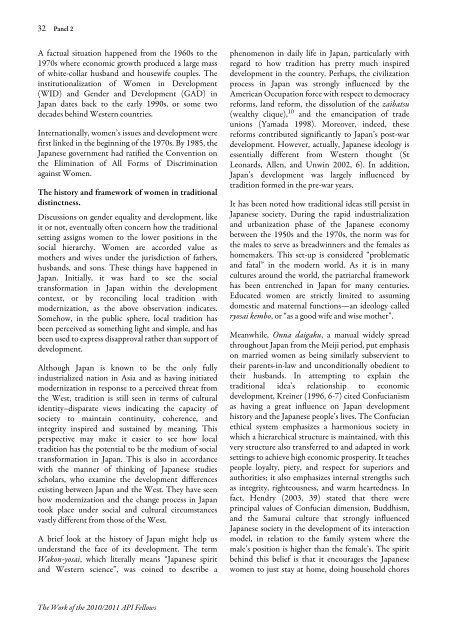Untitled - Api-fellowships.org
Untitled - Api-fellowships.org
Untitled - Api-fellowships.org
Create successful ePaper yourself
Turn your PDF publications into a flip-book with our unique Google optimized e-Paper software.
32 Panel 2A factual situation happened from the 1960s to the1970s where economic growth produced a large massof white-collar husband and housewife couples. Theinstitutionalization of Women in Development(WID) and Gender and Development (GAD) inJapan dates back to the early 1990s, or some twodecades behind Western countries.Internationally, women’s issues and development werefirst linked in the beginning of the 1970s. By 1985, theJapanese government had ratified the Convention onthe Elimination of All Forms of Discriminationagainst Women.The history and framework of women in traditionaldistinctness.Discussions on gender equality and development, likeit or not, eventually often concern how the traditionalsetting assigns women to the lower positions in thesocial hierarchy. Women are accorded value asmothers and wives under the jurisdiction of fathers,husbands, and sons. These things have happened inJapan. Initially, it was hard to see the socialtransformation in Japan within the developmentcontext, or by reconciling local tradition withmodernization, as the above observation indicates.Somehow, in the public sphere, local tradition hasbeen perceived as something light and simple, and hasbeen used to express disapproval rather than support ofdevelopment.Although Japan is known to be the only fullyindustrialized nation in Asia and as having initiatedmodernization in response to a perceived threat fromthe West, tradition is still seen in terms of culturalidentity–disparate views indicating the capacity ofsociety to maintain continuity, coherence, andintegrity inspired and sustained by meaning. Thisperspective may make it easier to see how localtradition has the potential to be the medium of socialtransformation in Japan. This is also in accordancewith the manner of thinking of Japanese studiesscholars, who examine the development differencesexisting between Japan and the West. They have seenhow modernization and the change process in Japantook place under social and cultural circumstancesvastly different from those of the West.A brief look at the history of Japan might help usunderstand the face of its development. The termWakon-yosai, which literally means “Japanese spiritand Western science”, was coined to describe aphenomenon in daily life in Japan, particularly withregard to how tradition has pretty much inspireddevelopment in the country. Perhaps, the civilizationprocess in Japan was strongly influenced by theAmerican Occupation force with respect to democracyreforms, land reform, the dissolution of the zaibatsu(wealthy clique), 10 and the emancipation of tradeunions (Yamada 1998). Moreover, indeed, thesereforms contributed significantly to Japan’s post-wardevelopment. However, actually, Japanese ideology isessentially different from Western thought (StLeonards, Allen, and Unwin 2002, 6). In addition,Japan’s development was largely influenced bytradition formed in the pre-war years.It has been noted how traditional ideas still persist inJapanese society. During the rapid industrializationand urbanization phase of the Japanese economybetween the 1950s and the 1970s, the norm was forthe males to serve as breadwinners and the females ashomemakers. This set-up is considered “problematicand fatal” in the modern world. As it is in manycultures around the world, the patriarchal frameworkhas been entrenched in Japan for many centuries.Educated women are strictly limited to assumingdomestic and maternal functions—an ideology calledryosai kembo, or “as a good wife and wise mother”.Meanwhile, Onna daigaku, a manual widely spreadthroughout Japan from the Meiji period, put emphasison married women as being similarly subservient totheir parents-in-law and unconditionally obedient totheir husbands. In attempting to explain thetraditional idea’s relationship to economicdevelopment, Kreiner (1996, 6-7) cited Confucianismas having a great influence on Japan developmenthistory and the Japanese people’s lives. The Confucianethical system emphasizes a harmonious society inwhich a hierarchical structure is maintained, with thisvery structure also transferred to and adapted in worksettings to achieve high economic prosperity. It teachespeople loyalty, piety, and respect for superiors andauthorities; it also emphasizes internal strengths suchas integrity, righteousness, and warm heartedness. Infact, Hendry (2003, 39) stated that there wereprincipal values of Confucian dimension, Buddhism,and the Samurai culture that strongly influencedJapanese society in the development of its interactionmodel, in relation to the family system where themale’s position is higher than the female’s. The spiritbehind this belief is that it encourages the Japanesewomen to just stay at home, doing household choresThe Work of the 2010/2011 API Fellows
















